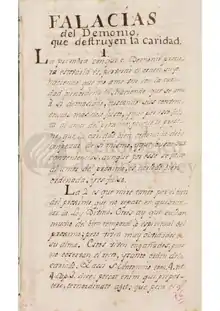Coahuiltecan languages
Coahuiltecan was a proposed language family in John Wesley Powell's 1891 classification of Native American languages.[1] Most linguists now reject the view that the Coahuiltecan peoples of southern Texas and adjacent Mexico spoke a single or related languages.[2] Coahuiltecan continues to be a convenient collective term for the languages and people of this region.
Language relationships

Similarities among the cultures among the indigenous people and the physical setting of south Texas led linguists to believe that the languages of the region were also similar.[3] The Coahuiltecan language family was proposed to include all the languages of the region, including Karankawa and Tonkawa. Linguistic connections were proposed with Hokan, a language family of several Native American peoples living in California, Arizona, and Baja California.[4]
Most modern linguists, by contrast, see the Coahuiltecan region as one of linguistic diversity. A few words are known from seven different languages: Comecrudo, Cotoname, Aranama, Solano, Mamulique, Garza, and Coahuilteco or Pakawa. Coahuilteco or Pakawa seems to have been a lingua franca of Texas Coahuiltecans living at or near the Catholic Missions established at San Antonio in the 18th century. Almost certainly, many more languages were spoken, but numerous Coahuiltecan bands and ethnic groups became extinct between the 16th and 19th century and their languages were unrecorded. In 1886, ethnologist Albert Gatschet found perhaps the last surviving speakers of Coahuiltecan languages : 25 Comecrudo, 1 Cotoname, and 2 Pakawa. They were living near Reynosa, Mexico.[5] In 1690, the population of Indians in northeastern Mexico and southern Texas may have been 100,000. The Coahuiltecans were sold into slavery, died of introduced European diseases, and were absorbed by the Hispanic population.[6]
Linguists have postulated a Comecrudan language family with Comecrudo, Mamulique, and Garza as related and Coahuilteco and Cotoname possibly related. Comecrudo and Cotoname are the best known of the languages. They were spoken in the delta of the Rio Grande.[7] Not enough information exists to classify Solano and Aranama. However, linguistic conservatives say that all these languages should be considered language isolates, with insufficient data to establish relationships between and among the languages.[8]
The Coahuiltecan languages and culture are now extinct. The names of many bands have been preserved, including the Ervipiame, Mayeye, Pajalat, Quems, Quepano, Solano, and Xarames.

References
- Powell, J. W. "Indian Linguistic Families of America, north of Mexico." Seventh Annual Report of the Bureau of Ethnology, 1885–1886. Washington: GPO, 1891, pp. 68–69
- Logan, Jennifer L. "Chapter 8: Linguistics" Reassessing Cultural Extinction: Change and Survival at Mission San Juan Capitstrano, Texas. College Station: Center for Ecological Archaeology, Texas A&M, 2001
- Newcombe, Jr., W. W. The Indians of Texas: from Prehistoric to Modern Times. Austin: U of TX Press, 1961, pp.29–30
- Sapir, E. "The Hokan and Coahuiltecan Languages. International Journal of American Linguistics. Vo. L, No 4 (Dec 1020), p. 280
- Powell, J. W. 7th Annual Report of the Bureau of Ethnology, 1885–1886. Washington: GPO, 1891, p. 68
- "Coahuiltecan Indians." Handbook of Texas Online. www.tshaonline.org/handhook/online/articles/bmcah, accessed 16 Feb 2012.
- Salinas, Martin. Indians of the Rio Grande Delta. Austin: U of TX Press, 1990, pp. 142–147
- Logan, Jennifer L. "Chapter 8: Linguistics" Reassessing Cultural Extinction: Change and Survival at Mission San Juan Capistrano, Texas. College Station: Center for Ecological Archaeology, Texas A&M, 2001
Bibliography
External links
- Coahuiltecan Indians from the Handbook of Texas Online
- Reassessing Cultural Extinction: Change and Survival at Mission San Juan Capistrano, Texas – Chapter 8: Linguistics
- "Pakawá Indians". Catholic Encyclopedia.
- "South Texas Plains » Who Were the "Coahuiltecans"?". Texas Beyond History. Austin: The University of Texas. Retrieved 4 October 2011.